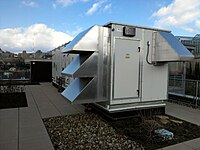
Photo from wikipedia
Abstract Waste solvents generated by the process industry are frequently incinerated as a part of their treatment, thus allowing for a partial recovery of their combustion heat. While large chemical… Click to show full abstract
Abstract Waste solvents generated by the process industry are frequently incinerated as a part of their treatment, thus allowing for a partial recovery of their combustion heat. While large chemical sites often have in-house waste incineration facilities, smaller enterprises have to outsource the treatment of their residuals, leading to significant shipments of hazardous substances. In this sense, there is a significant optimization potential to reduce both shipments and the consumption of auxiliary fuels, thus leading to an overall reduction of the primary energy required to produce and deliver chemical products and intermediates. However, inconsistent data systems and incomplete information represent main barriers for investigating the potential of such environmental benefits. As information about waste properties does not need to be reported, it is consequently not possible to rigorously estimate the energetic potential of the hazardous waste produced in a specific area, which would be a crucial first step in the optimization of both design and management of a supply chain network of industrial waste. This work proposes a novel approach for the estimation of hazardous waste properties, combining existing information stemming from industrial and institutional partners. Such framework creates a new waste classification system based on water and pollutant content that links inconsistent data sources with different degrees of detail, and allows for estimating average properties, including the energy content, of different types of primary produced hazardous liquid waste. The validity of the developed methodology for a broad application range is tested with a case study about Switzerland, which, because of its sparse chemical and pharmaceutical industry and an extreme variety in terms of generated waste residues, represents one of the most challenging cases. Such case study investigates the evolution of Swiss industrial waste from 2010 to 2014, determines average properties for 12 different waste classes and their total energy recovery potential.
Journal Title: Journal of Cleaner Production
Year Published: 2018
Link to full text (if available)
Share on Social Media: Sign Up to like & get
recommendations!